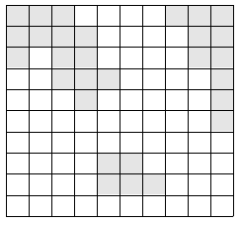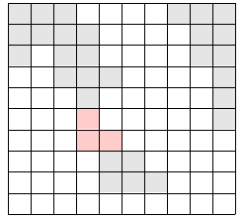문제
여러 섬으로 이루어진 나라가 있다. 이 나라의 대통령은 섬을 잇는 다리를 만들겠다는 공약으로 인기몰이를 해 당선될 수 있었다. 하지만 막상 대통령에 취임하자, 다리를 놓는다는 것이 아깝다는 생각을 하게 되었다. 그래서 그는, 생색내는 식으로 한 섬과 다른 섬을 잇는 다리 하나만을 만들기로 하였고, 그 또한 다리를 가장 짧게 하여 돈을 아끼려 하였다.
이 나라는 N×N크기의 이차원 평면상에 존재한다. 이 나라는 여러 섬으로 이루어져 있으며, 섬이란 동서남북으로 육지가 붙어있는 덩어리를 말한다. 다음은 세 개의 섬으로 이루어진 나라의 지도이다.

위의 그림에서 색이 있는 부분이 육지이고, 색이 없는 부분이 바다이다. 이 바다에 가장 짧은 다리를 놓아 두 대륙을 연결하고자 한다. 가장 짧은 다리란, 다리가 격자에서 차지하는 칸의 수가 가장 작은 다리를 말한다. 다음 그림에서 두 대륙을 연결하는 다리를 볼 수 있다.

물론 위의 방법 외에도 다리를 놓는 방법이 여러 가지 있으나, 위의 경우가 놓는 다리의 길이가 3으로 가장 짧다(물론 길이가 3인 다른 다리를 놓을 수 있는 방법도 몇 가지 있다).
지도가 주어질 때, 가장 짧은 다리 하나를 놓아 두 대륙을 연결하는 방법을 찾으시오.
접근 방법
-
육지와 바다로 나뉘어져 있어 BFS로 육지마다 고유의 지역 숫자를 설정해줍니다.
-
모든 노드를 탐색하며 방문하지 않은 지역을 접근하면 해당 지역의 좌표와 고유의 지역 숫자를 바탕으로 가장 가까운 위치에 있는 지역까지 BFS를 통해 탐색합니다.
-
새로운 지역을 만나면 static에 올라와 있는 distance 값을 갱신합니다.
소스 코드
import java.io.BufferedReader;
import java.io.IOException;
import java.io.InputStreamReader;
import java.util.ArrayDeque;
public class MakeBridge {
static int n;
static int[][] graph;
static int distance = Integer.MAX_VALUE;
static int[] dx = new int[]{-1, 0, 1, 0};
static int[] dy = new int[]{0, 1, 0, -1};
static class Node {
int x;
int y;
int move;
public Node(int x, int y, int move) {
this.x = x;
this.y = y;
this.move = move;
}
}
public static void main(String[] args) throws IOException {
BufferedReader br = new BufferedReader(new InputStreamReader(System.in));
n = Integer.parseInt(br.readLine());
graph = new int[n][n];
for (int i = 0; i < n; i++) {
String[] input = br.readLine().split(" ");
for (int j = 0; j < n; j++) {
graph[i][j] = Integer.parseInt(input[j]);
}
}
int regions = regionNumbering(); // 지역 개수
boolean[] visitedRegion = new boolean[regions]; // regions 는 실제보다 1 크다
for (int i = 0; i < n; i++) {
for (int j = 0; j < n; j++) {
if (graph[i][j] != 0 && !visitedRegion[graph[i][j]]) {
visitedRegion[graph[i][j]] = true;
findShortest(graph[i][j], i, j);
}
}
}
System.out.println(distance);
}
// region Number 지역으로부터 가장 짧은 거리를 가지는 region 을 return
public static void findShortest(int regionNumber, int regionX, int regionY) {
ArrayDeque<Node> dq = new ArrayDeque<>();
boolean[][] visit = new boolean[n][n];
dq.offerLast(new Node(regionX, regionY, 0));
visit[regionX][regionY] = true;
while (!dq.isEmpty()) {
Node now = dq.removeFirst();
if (now.move >= distance) {
continue;
}
for (int i = 0; i < 4; i++) {
int tmpx = now.x + dx[i];
int tmpy = now.y + dy[i];
if (0 <= tmpx && tmpx < n && 0 <= tmpy && tmpy < n && !visit[tmpx][tmpy]) {
if (graph[tmpx][tmpy] == regionNumber) {
dq.offerLast(new Node(tmpx, tmpy, 0));
visit[tmpx][tmpy] = true;
} else if (graph[tmpx][tmpy] == 0) {
dq.offerLast(new Node(tmpx, tmpy, now.move + 1));
visit[tmpx][tmpy] = true;
} else {
distance = Math.min(now.move, distance);
}
}
}
}
}
public static int regionNumbering() {
ArrayDeque<Node> dq = new ArrayDeque<>();
boolean[][] visit = new boolean[n][n];
int cur = 1;
for (int i = 0; i < n; i++) {
for (int j = 0; j < n; j++) {
if (!visit[i][j] && graph[i][j] != 0) {
dq.offerLast(new Node(i, j, 0));
graph[i][j] = cur;
visit[i][j] = true;
while (!dq.isEmpty()) {
Node now = dq.removeFirst();
for (int k = 0; k < 4; k++) {
int tmpx = now.x + dx[k];
int tmpy = now.y + dy[k];
if (0 <= tmpx && tmpx < n && 0 <= tmpy && tmpy < n && !visit[tmpx][tmpy] && graph[tmpx][tmpy] != 0) {
graph[tmpx][tmpy] = cur;
visit[tmpx][tmpy] = true;
dq.offerLast(new Node(tmpx, tmpy, 0));
}
}
}
cur++;
}
}
}
return cur;
}
}결과

